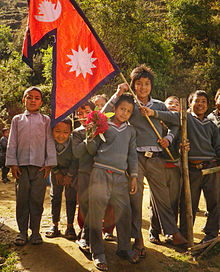Minority group
![]()
This article is about the socio-philosophical concept of minority. For further information see: democratic minority.
A minority (also minority or minority number) is a numerically smaller part of a totality, which differs from the majority by personal or cultural characteristics. As a demographic group, a minority usually lives in a specific territorial unit (state, region...), but may also be scattered over the area of residence of the majority or live in several neighbouring states.
The distinguishing characteristics of minorities are usually language, ethnicity or religion, but moral concepts, sexual identity or social function can also constitute the status of minorities. A minority exists when a group is dominated and minoritized by a numerically larger group of a territory without assimilating.
In the traditional sense, minorities are ethnic, religious or national minorities, i.e. population groups on the territory of a state in contrast to a certain majority of the population.
The UN and other international organisations have adopted minority rights. They are respected in different ways (see also Protection of minorities, Human rights). In 1988 the IMADR (International Movement Against All Forms of Discrimination and Racism) was founded in Tokyo, which draws attention to the problems and discrimination of minorities and campaigns for the rights of disadvantaged ethnic groups.
Social psychology distinguishes between two types of minorities: a numerical-statistical one and a social one. The latter describes a minority that differs from the rest of society by cultural and/or psychological characteristics and is thus regarded as inferior by the socially dominant group and is treated as such.
Under the influence of US sociology, the term "minority" has undergone a change in meaning over the last fifty years. The term is applied to virtually all groups that numerically constitute less than half of a given population, whose appearance and demeanor deviate from prevailing customs and behavior, and who have less influence than the rest of the population.

Group of students from the Tamang minority in Nepal
International Law
→ Main article: International law
There is no binding definition of "minority" under international law from a political point of view.
In the context of the UN Special Commission on Minorities, the following (very broadly or generally defined) elements are often considered to be constitutive of a "minority":
- numerical inferiority in relation to the total population of a country
- non-dominant position in this state
- ethnic, religious or linguistic similarities
- a sense of solidarity or identity through a self-perception as a minority
The view that the nationality of the State of residence is also a constitutive element was rejected by the UN Human Rights Committee in 1994.
Minority types
There are countless attempts to categorize and typologize minorities. A rough distinction, which is also used in the context of international law, is the following division:
- Ethnic minorities: Ethnic groups living on the territory of a state formed by a majority of another ethnic group.
- National minorities: Ethnic minorities covered by the provisions of the Council of Europe Framework Convention for the Protection of National Minorities.
- Linguistic minorities: Are not an ethnic or national minority, but speak a different mother tongue than the majority population in the state. Examples: Francophone population of Switzerland, sign language speakers (compare also audism), sign language is recognized as a minority language in Austria and Switzerland.
- Religious minority: Examples: Protestants in France, Austria, Poland or Russia, Catholics in East Germany and large parts of North Germany, Oriental Christians in the Middle East, Christians in China, Muslims in Europe or India, Buddhists in Pakistan and Bangladesh, Alevis in Turkey, Bahai in Egypt or Iran.
- Minority of old people
- Minorities of sexual orientation (homosexuals, bisexuals, pansexuals, etc.)
- minorities of social classes (unemployed, homeless, financially poor people or the Sinti and Roma)
- Blocking minorities, which can prevent a decision from being taken in the case of votes.
A further typification distinguishes between minority characteristics that are collective-family (e.g. ethnic minorities) or individual (e.g. sexual orientation, disability). In the case of the individual variant, a further distinction must be made according to whether it is given or has arisen as a result of a conscious decision (e.g. by converting to a religious minority).
Search within the encyclopedia